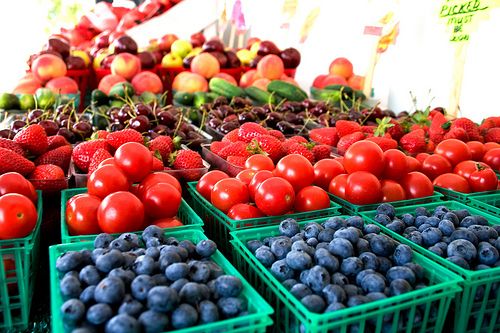Jamie recently wrote in to Simple Mom asking, “I’m trying to lose a little baby weight, and wondered if you have ideas for losing weight without going overboard.”
I hear these kinds of questions from so many mothers — “How can we keep ourselves healthy and in top shape while managing the demands and busy lifestyle of raising a family?” All too often, I see women jumping from one diet plan to the next, trying to count the right number of calories, or eat the right combinations of foods in order to lose the weight, feel more energy and regain mental clarity. And time after time, this approach fails and leaves them feeling overwhelmed and deflated.
There must be (and is!) a better way.
Seeing the weight loss and healthy living picture from a different perspective is essential to getting our health back on track. We have become so indoctrinated with the “no pain, no gain” mantra of modern diet regimes, that at first glance, a healthy living perspective that is gentle, loving and affirming feels impotent.
But the truth is, focusing our efforts on nourishing and caring for ourselves dissolves the old patterns and power struggles that we’ve had with food. It frees us up to do what is best for our body and then get on to living with more vitality, energy and focus.
Here are five key principles of healthy living that are sourced from the rhythms and precepts found in nature.
1. Follow the Seasons
Returning to the wisdom built into the harvest is a simple, healthy way to feed your body. When we lived closer to the earth and sourced our survival based on the available foods in each season, this way of eating would have been as intuitive as breathing.
In today’s world, we shop from artificially-lit supermarket aisles that give us an unnatural array of food options all year long. We have lost the healing benefits of eating foods in the right seasons.
When we are in a cold, dry season, the appropriate foods are those that bring us warmth and moisture. We need this balance to stay well. In spring, when we have excess heaviness from a winter diet, we find the antidote in springtime foods — they naturally cleanse and detoxify.
Without memorizing long lists of do and don’ts, following a seasonal pattern of eating gives your body what it needs naturally and frees up your mental energy away from obsessing about food.
- Winter foods build, warm and emulsify with vegetables like sweet potato, winter squashes, onion, garlic, coconut, and avocado.
- Spring foods cleanse, detoxify and lighten through sprouts, salad greens, peas, celery, and spinach.
- Summer infuses us with nutrient-dense, colorful produce emphasizing the bounty of the year’s harvest, highlighting fresh berries, melons, summer squashes, green leafy salad vegetables, asparagus and broccoli.
- Fall transitions us from the summer harvest and gets us ready for the building months of winter with warm, yet cleansing foods like apples and pears, dark leafy greens, cabbage and pomegranate.
2. Use the Character of Foods
“No foods are forbidden, except when your body tells you so.” – Lima Ohsawa

All whole and natural foods (this excludes processed, chemicalized, artificial or sugar laden food products) have an appropriate place in our diets. Some foods in nature are cleansing, and some are building foods. Some are warming and some are cooling. Some are expansive, some are contractive.
Learning how different foods impact our bodies gives us an elegant tool when we begin to feel out of sorts or imbalanced. If you are having a hard time concentrating and focusing, you can use that information to bring in foods or wellness practices that help ground you and regain your focus. In this way we build confidence in listening to ourselves, because our focus is on how we can best nourish ourselves.
Weight loss goals become an opportunity to choose whole foods that will naturally flush fat and toxins from our system and energize our metabolism. — as opposed to a plan full of dos, don’ts and restrictions.
3. Hydration
Think about foods in their natural state. If they are ready to eat, they are mostly high in water content (like fruits and vegetables). If they require cooking (like grains and beans), they absorb and hold water through the cooking process.
Nature’s foods naturally work to hydrate us. Processed foods are often dry and dehydrating. It is built into nature’s design to keep us well hydrated.
Drinking enough water is essential in our efforts to regain our healthy energy, weight, and moods back. Check out this post for some ways to stay hydrated.
4. Experience the Elements
“Everybody needs beauty as well as bread, places to play in and pray in, where nature may heal and give strength to the body.” – John Muir
One of the ruts we can get into when leading busy, overbooked lives is to disengage from nature. Shallow breathing, lack of physical movement, tightness from cramped posture and excessive sitting, artificial light from indoor and screen sources, stuffy recycled air… all of these things keep us from maintaining wellness.
One of the suggestions I often give clients who are nature-starved is to take their lunch outside. Once, for a woman who ate her lunch in the car every day, I asked her to park the car in a nearby park looking out at the trees and scenery and to give herself a few minutes simply looking at nature while she ate. After months of counseling, this was one of the shifts she credits most to helping her regain control of her eating habits and begin to lose weight.
When we connect to nature all throughout the year, we benefit. We receive the necessary oxygen from the fresh air and exposure to direct sunlight. We engage, stretch and energize our body when we take physical activity outdoors, even for a ten-minute brisk walk. We gain mental balance and renewal from seeing the colors, smells, and changes of the seasons.
Nature is an essential part of our wellness routine–too often overlooked and ignored in a busy modern lifestyle.
5. Take Food Out of Center Stage

This may be the most important lesson of all. We have become a people thoroughly obsessed with food. We think about it all the time. What should I eat? What should I not eat? Why did I just eat that? What’s for dinner? We read countless books on diets, nutrition and ways of eating, trying to make sense of it all and to find that magic bullet that will be the “perfect” diet.
We were never meant to think about food this much. But our internal focus on food is such a hard mental habit to break.
Gently, but persistently retraining our thoughts away from food is essential to having a healthy relationship with it— it was never meant to have that much power in our lives, and it creates imbalance and stress when it takes center stage in our priorities.
Each of the above four principles will naturally shift food into its appropriate place.
- Eating seasonally keeps our food choices simple and enjoyable— it removes the need for complicated diet plans or calorie counting, and gives us permission to enjoy all types of foods in their time throughout the year.
- Using food as a positive, helpful tool to keep us balanced shifts our thoughts away from foods we can’t have to what foods we can have. This subtle change releases the mental obsession and bingeing that can happen when we focus on restricting foods (ever told yourself “no more desserts,” and found the only thing you thought about all day was dessert?).
- Keeping well-hydrated prevents us from misreading thirst cues for hunger cues, which we often mistaken for one another.
- Getting into nature gives us an opportunity every day to have clarity of mind and to feel uplifted and energized. Many times we eat to manage mental dullness, boredom or energy lulls.
Sometimes it is simply a change of lens that is required to begin seeing things in a different light. Consider the ways you’ve gone about managing your health, weight and mood. Could it be that a gentle perspective shift makes all the difference in your journey?
If you’re interested in learning more about how food can be used to cleanse and detoxify, I invite you to read more about my ebook, The Real Food Cleansing Guide.
What about you? Have you learned ways to best nourish yourself that are reflected within the design of nature? What principles of healthy living do you adhere to?
top photo source


